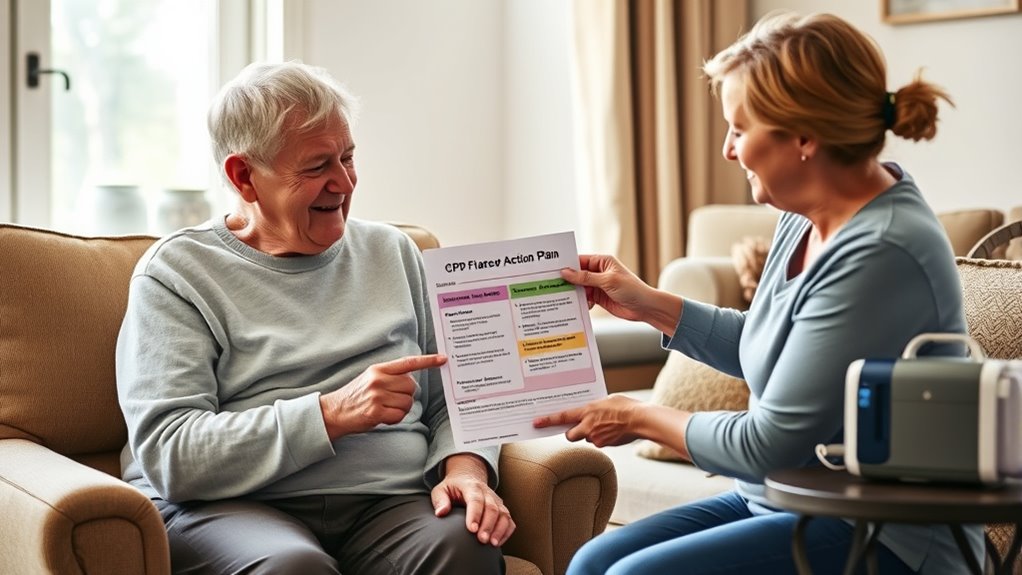When managing a COPD flare-up, you should recognize early signs like increased breathlessness, coughing, or fatigue. Prepare a personal emergency kit with medications, contact info, and helpful equipment. During a flare, sit upright, use prescribed inhalers, and stay calm. Seek emergency help if symptoms worsen or include chest pain or blue lips. Regularly communicate with healthcare providers and keep your environment clean. For detailed steps to support your loved one effectively, keep exploring these essential strategies.
Key Takeaways
- Develop and maintain a detailed emergency plan including medication, symptoms, triggers, and healthcare contacts.
- Prepare and organize an accessible COPD emergency kit with prescribed medications and necessary equipment.
- Recognize early signs of a flare-up and know immediate steps like using inhalers, sitting upright, and monitoring oxygen levels.
- Know when to seek emergency help, including calling 911 for severe symptoms like difficulty breathing or blue discoloration.
- Communicate regularly with healthcare providers and keep detailed notes to ensure prompt, effective response during flare-ups.
Recognizing Early Signs of a COPD Flare-Up
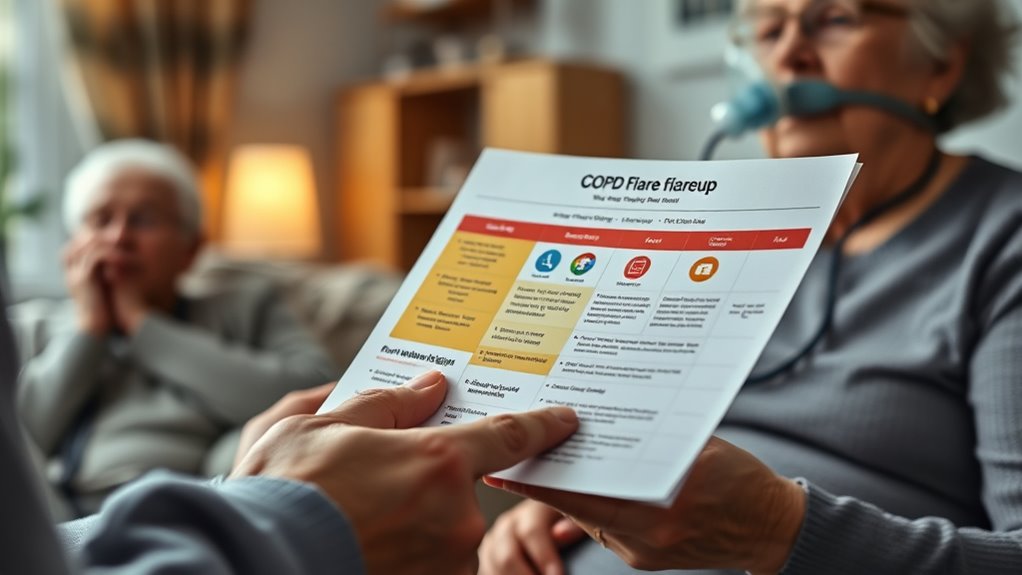
Recognizing the early signs of a COPD flare-up is essential for managing your condition effectively. You might notice increased shortness of breath during daily activities or at rest. Coughing could become more frequent or severe, and your sputum might change in color or amount. You may also feel more fatigued or notice a tightness in your chest. Changes in your breathing patterns, such as wheezing or difficulty catching your breath, are key warning signs. Being aware of these symptoms allows you to act quickly, preventing the situation from worsening. Keep track of any new or unusual symptoms, as early recognition is critical for timely intervention and to avoid hospitalization. Staying attentive to your body helps you stay in control. Monitoring symptom changes can help identify worsening conditions early. Additionally, understanding the role of machine learning algorithms in healthcare can improve predictive tools used to detect early signs of exacerbation. Regularly checking your indoor air quality can also play a part in managing respiratory health and preventing triggers. Incorporating patient education about symptom recognition can further empower caregivers to respond promptly. Awareness of environmental factors like pollutant levels can further help in preventing flare-ups before they start.
Preparing a Personal Emergency Kit for COPD Care
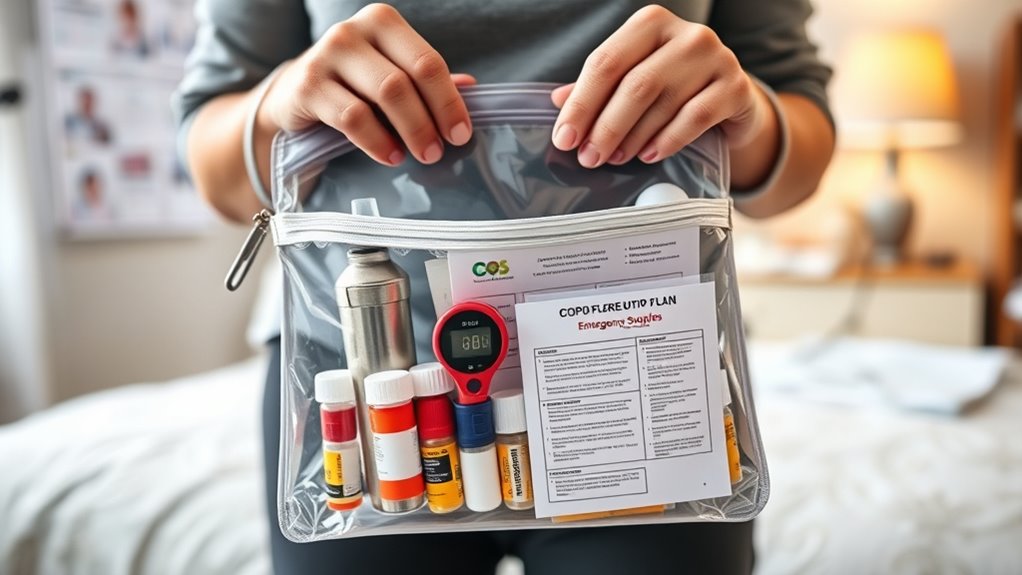
Being prepared for a COPD flare-up can make all the difference in managing your condition effectively. Start by assembling a personal emergency kit that includes your prescribed medications, such as inhalers or nebulizers, and keep extra supplies on hand. Include a list of your healthcare provider’s contact information and emergency contacts. Pack a spacer device if you use one, along with tissues, hand sanitizer, and a small flashlight. Consider adding a pulse oximeter to monitor your oxygen levels and any necessary masks or breathing aids. Store everything in a portable, easy-to-access bag, and review the contents regularly to guarantee supplies are current. Incorporating proper storage techniques can help maintain the integrity of your supplies and ensure readiness. Utilizing digital literacy programs can also assist in understanding and managing your equipment more effectively. Using air quality awareness can help you avoid triggers that may worsen your symptoms. Having this kit ready means you’ll be prepared to act quickly and confidently if symptoms worsen unexpectedly.
Immediate Steps to Take During a Flare-Up
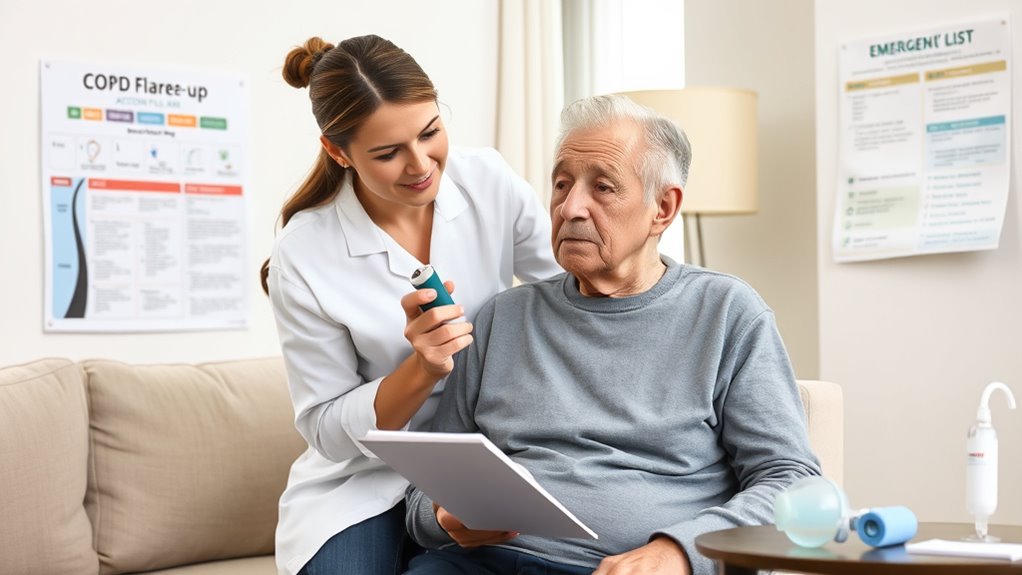
When a COPD flare-up occurs, taking prompt action can prevent your condition from worsening. First, sit upright to help your lungs expand more easily. Use your prescribed quick-relief inhaler immediately, following the correct dosage. Stay calm and breathe slowly to avoid panic, which can make breathing harder. Check your oxygen levels if you have a pulse oximeter, and adjust your oxygen flow as instructed by your healthcare provider. Remove any irritants from your environment, like smoke or strong fumes. Drink small sips of water to stay hydrated, but avoid large amounts that might cause discomfort. Monitor your symptoms closely—if they worsen or do not improve quickly after these steps, be prepared to seek emergency help.
When to Seek Emergency Medical Assistance
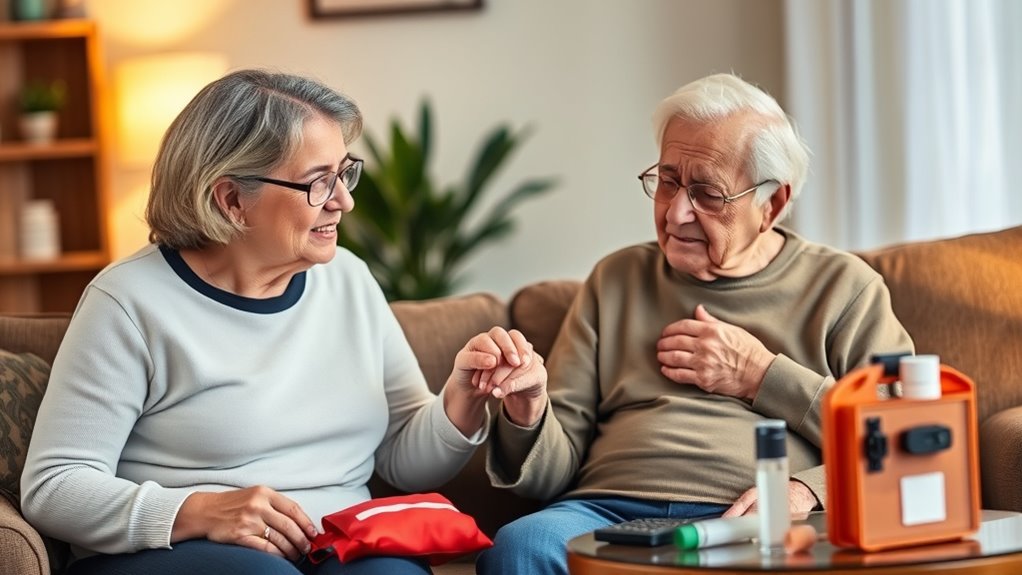
If you notice severe symptoms like extreme shortness of breath, chest pain, or blue lips, it’s vital to get help immediately. Don’t hesitate to call 911 if your condition worsens quickly or doesn’t improve with usual measures. Acting promptly can prevent serious complications and save your life.
Recognizing Severe Symptoms
Severe symptoms during a COPD flare-up signal that you need emergency medical help immediately. If your loved one experiences extreme difficulty breathing, with lips or face turning blue or gray, seek help right away. Persistent chest pain or pressure that doesn’t improve with usual medications is another warning sign. If they become unresponsive, lose consciousness, or can’t speak or respond to questions, call emergency services immediately. Rapid or very shallow breathing, along with confusion or severe fatigue, also indicate a need for urgent care. Recognizing these signs early can be life-saving. Don’t hesitate to get professional help if any of these symptoms occur—timely intervention can prevent further complications and ensure your loved one gets the care they need promptly.
When to Call 911
Knowing when to call 911 can make the difference between getting prompt help and facing serious health risks. If your loved one’s symptoms worsen suddenly or severely, don’t hesitate to seek emergency assistance. Call 911 immediately if they experience:
- Severe difficulty breathing or gasping for air
- Chest pain or tightness that doesn’t improve
- Blue lips or fingertips
- Loss of consciousness or inability to respond
These signs indicate a life-threatening situation that requires urgent medical attention. Acting quickly can prevent complications and stabilize their condition. Trust your instincts—if anything feels beyond normal flare-up symptoms or if you’re unsure, it’s safer to call 911. Prompt emergency response can save lives and ensure your loved one gets the care they need.
Effective Communication With Healthcare Providers
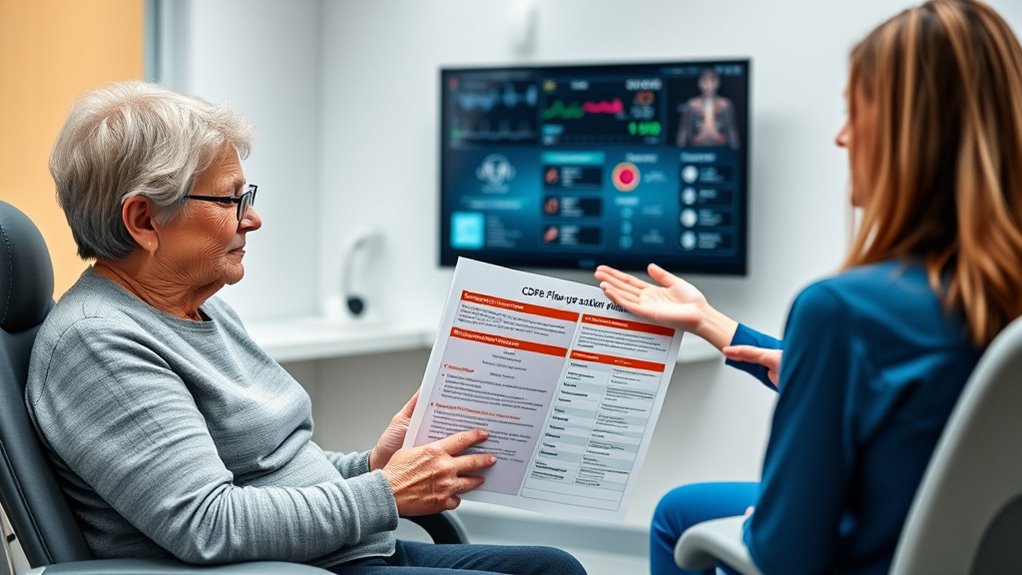
When talking to your healthcare provider, be clear and concise about your symptoms and concerns. Prepare detailed notes on your flare-ups, medication use, and any changes in your condition. This helps guarantee you communicate effectively and get the support you need. Additionally, knowing the support hours for your local healthcare services can help you plan urgent consultations efficiently. Being aware of symptom management strategies can also empower you to respond promptly during a flare-up. Remember, understanding fatherly guidance and support can be beneficial in managing your health effectively. Incorporating essential oils for symptom relief, such as eucalyptus or peppermint, may provide complementary relief during respiratory distress. Familiarizing yourself with privacy policies related to health information can ensure your data remains protected while seeking support.
Clear, Concise Messaging
Clear and concise communication with your healthcare provider is essential during a COPD flare-up. When you speak clearly, you guarantee they understand your symptoms and can respond promptly. Focus on sharing specific details like the severity of breathing difficulty, changes in cough, or new symptoms. Avoid jargon or vague descriptions, sticking to straightforward language. This helps your provider make accurate assessments and decisions quickly. Remember, your goal is to deliver the key information without unnecessary details. Effective messaging can prevent delays in treatment and improve outcomes.
- Use precise descriptions of symptoms and their duration
- Prioritize the most important information first
- Avoid ambiguous phrases or medical jargon
- Confirm understanding by asking clarifying questions
Prepare Detailed Notes
Having detailed notes ready before discussing a COPD flare-up guarantees you can communicate your symptoms accurately and efficiently. Write down key information such as when symptoms started, their severity, and any patterns you’ve noticed. Include recent changes in medication, triggers, and your overall health status. This preparation helps healthcare providers understand the situation quickly and determine the best course of action. To organize your notes effectively, consider this table:
| Symptom/Change | Details/Notes |
|---|---|
| Onset | When did symptoms begin? |
| Severity | Mild, moderate, severe? |
| Triggers | What caused the flare-up? |
| Medications | Any recent adjustments? |
Clear, organized notes make communication smoother and ensure nothing important gets overlooked during appointments.
Managing Symptoms at Home Safely
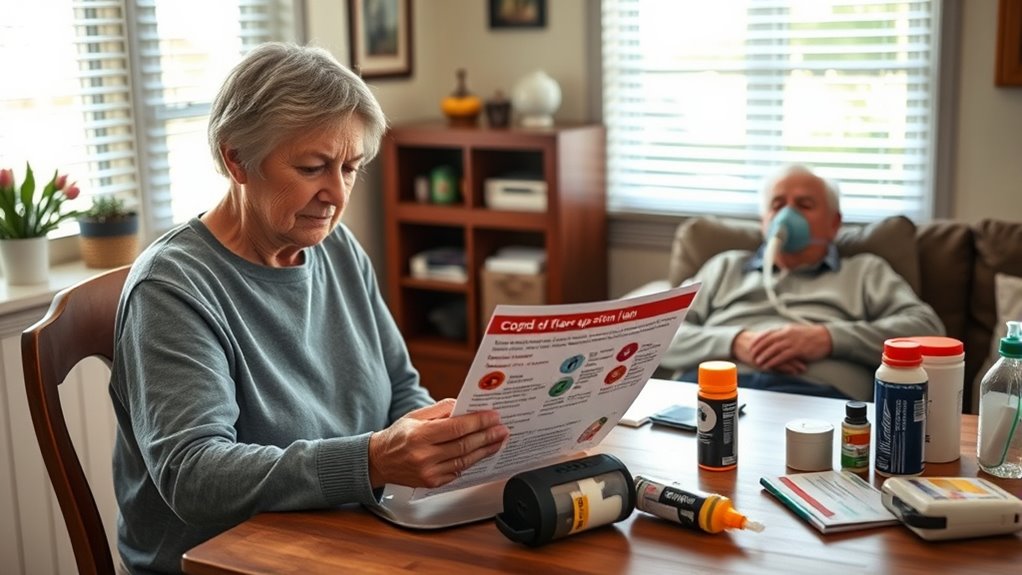
Managing your symptoms at home safely is essential to prevent a COPD flare-up from worsening. When you notice early signs, take immediate action to control symptoms and avoid hospitalization. Stay organized with your medications, ensuring you’re taking the right doses at the right times. Keep track of your breathing patterns and oxygen levels if prescribed. Stay calm and avoid activities that make breathing more difficult. Maintain a clean environment to reduce irritants like dust and smoke. Communicate regularly with your healthcare provider for guidance.
- Keep an emergency medication kit accessible
- Use a peak flow meter to monitor breathing
- Avoid allergens and irritants at home
- Rest when feeling fatigued or short of breath
Preventative Measures to Reduce Flare-Ups
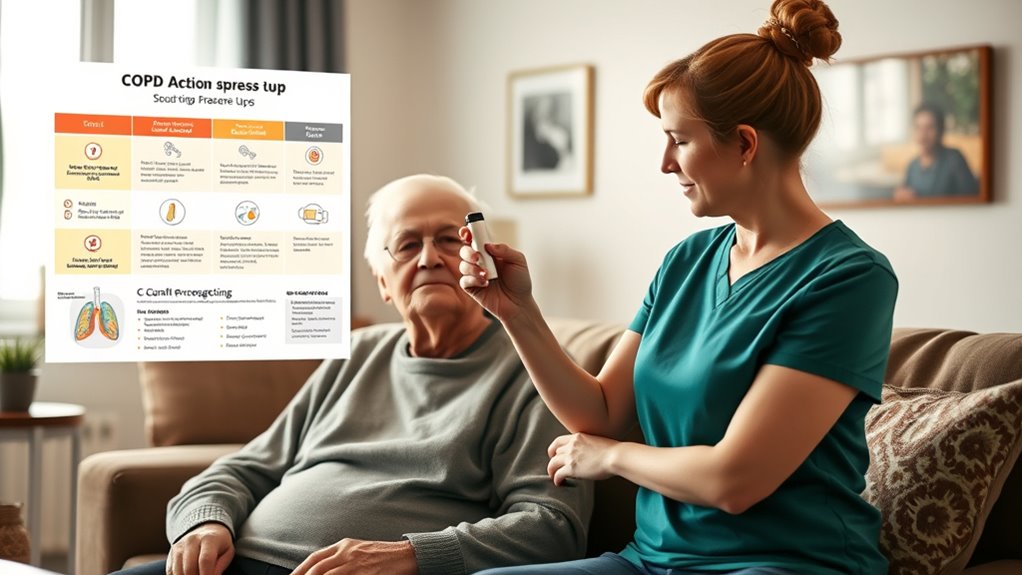
To effectively reduce the risk of COPD flare-ups, adopting preventative measures is crucial. First, make certain your loved one avoids exposure to irritants like cigarette smoke, pollution, and strong fumes. Keeping the environment clean and dust-free helps minimize triggers. Encourage regular medication use as prescribed, including inhalers and other treatments, and verify they’re taken correctly. Promote a healthy lifestyle by supporting balanced nutrition, regular exercise within their capacity, and adequate hydration. Monitoring symptoms daily helps catch early signs of worsening lung function. Additionally, maintaining routine check-ups with healthcare providers ensures any issues are addressed promptly. Vaccinations, such as the flu shot and pneumonia vaccine, also play an essential role in preventing infections that can cause flare-ups. Taking these steps can markedly lower flare-up risks and improve overall lung health.
Supporting Emotional Well-Being During COPD Flare-Ups

When a COPD flare-up occurs, emotional well-being can quickly become overwhelmed, yet supporting mental health is essential for overall recovery. During these times, you play a crucial role in helping your loved one manage stress and stay calm. Encourage open communication, listen without judgment, and reassure them that they’re not alone. Creating a peaceful environment can reduce anxiety and promote a sense of security. Recognize signs of emotional distress early, like agitation or withdrawal, and address them with empathy. Remember, your support can boost confidence and resilience. Developing coping strategies together can empower your loved one to better handle future flare-ups.
- Offer reassurance and validation of feelings
- Help establish a calming routine
- Encourage breathing exercises or mindfulness
- Stay patient and avoid rushing decisions
Frequently Asked Questions
How Can Caregivers Predict a Flare-Up Before Symptoms Appear?
You can often spot a potential flare-up early by paying close attention to subtle changes in breathing, increased coughing, or slight wheezing. Monitoring your loved one’s usual symptoms helps you notice when things deviate from the norm. Keep track of their energy levels and any signs of discomfort. Regularly checking their oxygen levels with a pulse oximeter can also alert you to early issues before symptoms become severe.
What Are Common Triggers That Caregivers Should Monitor?
You should watch for common triggers like respiratory infections, which weaken lung function, and exposure to irritants such as smoke, fumes, or strong perfumes. Weather changes, especially cold or humid air, can also provoke symptoms. Physical exertion might worsen breathing, so monitor activity levels. Stress and poor air quality are additional triggers. Staying alert to these factors helps you act quickly to prevent or manage flare-ups effectively.
How Do Medication Adjustments Impact Flare-Up Prevention?
You should understand that medication adjustments can substantially prevent flare-ups. When you work with the healthcare provider to fine-tune medications, it helps control symptoms and reduce inflammation. Taking the right dose at the right times keeps your loved one’s lungs healthier, lowering the risk of sudden exacerbations. Regularly reviewing and updating medications ensures they’re effective, so you can stay ahead of potential flare-ups and maintain better breathing.
What Lifestyle Changes Support Long-Term COPD Management?
You might think lifestyle changes won’t make much difference, but they actually play a big role in managing COPD long-term. Incorporate regular exercise, quit smoking, and eat a healthy diet to boost your lung health. Avoid pollutants and allergens that can worsen symptoms. Staying active and maintaining a healthy weight help improve breathing and energy levels. These steps empower you to take control and reduce flare-ups over time.
How Can Caregivers Handle Emotional Stress During Flare-Ups?
When managing emotional stress during flare-ups, you can take deep breaths to stay calm and focus on your breathing. Remember to reach out for support from friends, family, or support groups to share your feelings. Taking breaks, practicing relaxation techniques, and staying organized help you feel more in control. By caring for your mental health, you can better support your loved one through challenging times.
Conclusion
By staying vigilant and prepared, you hold the power to navigate COPD flare-ups with confidence. Remember, each step you take is a stitch in the fabric of your loved one’s well-being—strengthening their resilience and your bond. Don’t underestimate the importance of proactive care; it’s the lighthouse guiding you through stormy seas. With knowledge and compassion, you can turn challenging moments into opportunities for comfort and hope.
